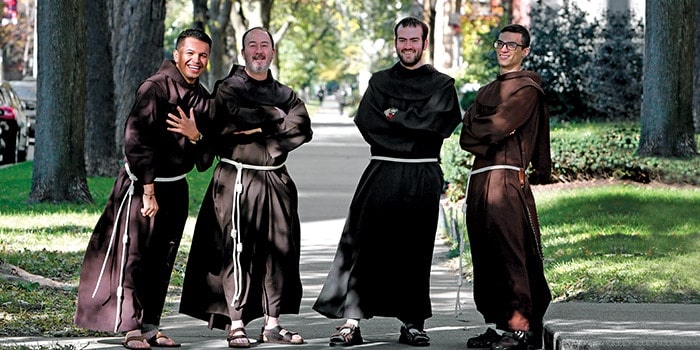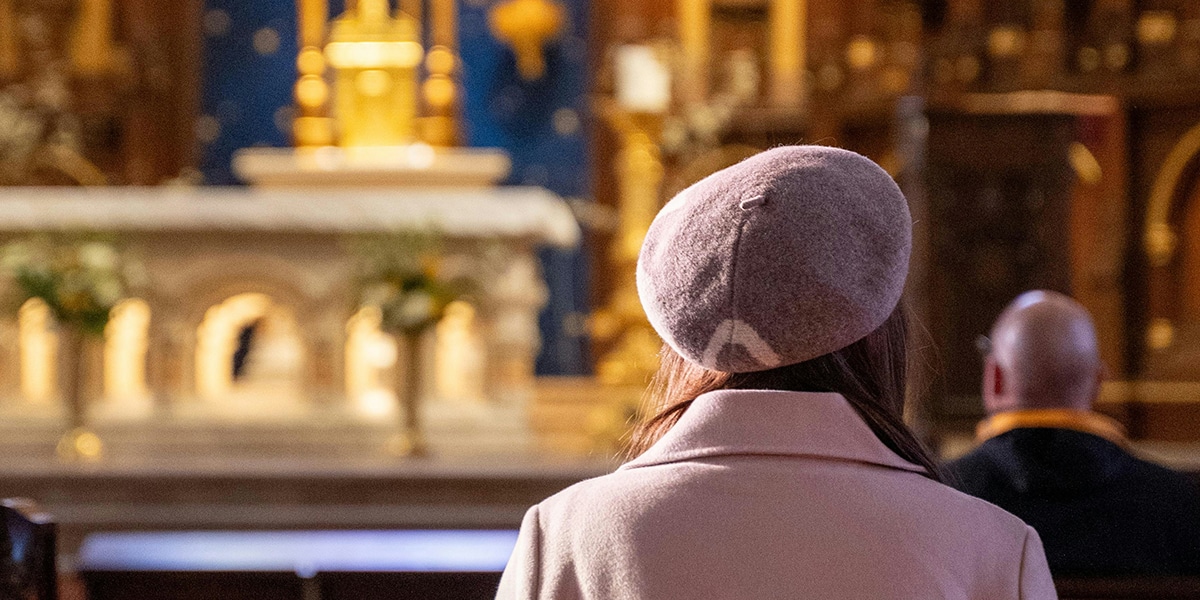The next generation of friars will certainly be smaller than the current one. What might that mean?
We hear all sorts of statistics about the closing and merging of parishes, the crisis of priestly vocations, the shrinking of religious orders. Those things are happening, but there’s new life brewing too. Ask a young or new Franciscan today about the future, and you hear a lot of hope. “We’re not thinking, It’s going to be terrible around here. What are we going to do? No, we just have to work all together,” says Abel Garcia, OFM.
Friar Abel lives at St. Joseph Friary, near Catholic Theological Union, one of the largest Catholic theology schools in the English-speaking world. We are on Chicago’s South Side, a community well known for its struggle against gang violence and murder, but we’re in Hyde Park, an oasis of sorts. The University of Chicago is a few blocks south; the Museum of Science and Industry is a few blocks east; a few hundred feet farther are joggers, walkers, and cyclists on the 18-mile Lakefront Trail—at least when weather permits anyone to recreate by Lake Michigan. As you read this, Chicago’s blistering winds and inches of snow are more likely.
There are 18 friars from various states at St. Joseph’s, a thriving community where, in a large red brick house-turned-friary, they gather early in the morning and again in the evening, between ministry, classes, and study, for Liturgy of the Hours and daily Eucharist. It’s a far cry from the isolated, huge institutions of the past.
“O Lord, open my lips,” proclaims today’s cantor. As these friars are seated around a front room to form a simple choir for prayer, one hears through the window every so often the brakes, the doors opening, the bell and announcement, the doors closing, then the muffled roar of the city buses on Route 55. The stop is just beyond the front porch. “And my mouth will proclaim your praise,” responds the group in unison. Thirteen friars-in-training, guided by the example of the other five, are learning their new lifestyle among the people of God, in the heart of a bustling city.
What is it about being a Franciscan? We gathered a group of four relatively new friars at a table in the corner of St. Joseph’s basement recreation room and asked them. Three of these men are in their 20s and 30s, and one is just over 50, all of them in the Order of Friars Minor (OFM), the Franciscans who sponsor this magazine.
All have completed the earliest stages of formation and now are professed for one year at a time as they move through this program of study and further discernment. At each man’s final, solemn profession, he will promise a lifetime of poverty, obedience, and celibacy, in Franciscan community, for one purpose: spreading the good news of Jesus in word and deed.
Meet Friars Joshua Critchley, Jim Bernard, Abel Garcia, and John Boissy. A few months ago, just before All Saints’ Day, we talked about their hopes and dreams for the future. These friars look to a future living in a changing Church, and are moving toward a time when there certainly will be far fewer Franciscans.
‘Where People Have the Most Need’
“There are almost two different cultures going here,” says Friar John, quickly qualifying, “I’m not pushing that; I’m just observing that.” He is speaking of how he is preparing to be in the smaller Franciscan Order of the future, even in the midst today of a larger, older group of friars, most of whom joined in the years before so many people from all over left celibate ministry, after which so few younger men joined. A nearby friar nods in affirmation. The days of high school seminaries are a distant memory.
Friar John is an aspiring lay brother—24 years old, a woodworker by interest who hopes to continue in that direction. He was on a waiting list to go to furniture-making trade school and working two jobs (ski instructor and parking garage assistant) when he responded to a deeper calling.
Among the Franciscans, Friar John sees a place where he will be appreciated for who he is: “The friars respect each individual’s gifts.” That didn’t seem always to be the case when he looked at other orders. “The friars were definitely the most open to me and my desire for woodworking and furniture making.” So, in future Franciscan life, Friar John sees a place for simplicity, for working with his hands with the respect of the friars around him. He’s a member of Cincinnati’s St. John the Baptist Province.
Friar Jim, at age 51 the oldest of the friars at this table, was a New York banker. His home parish is St. Francis of Assisi in lower Manhattan. In his pre-friar days, he walked by it each day on his way to work as an executive, managing 30 people at a multibillion-dollar banking firm. He fidgets with his Franciscan cord occasionally during our discussion; perhaps he’s just getting used to wearing it. In Manhattan, he found time to do volunteer work at the parish, including serving on a Rite of Christian Initiation of Adults team (training incoming Catholics) and working in some of the community outreach programs, among them the friars’ famous St. Francis Soup Kitchen. “I was inspired by the friars who I worked with there,” he says.
His future seems a bit unclear at this point: “To be honest, I haven’t met a ministry I haven’t liked yet, which is kind of a problem when you’re discerning about what you want to do in the future!” he says. But, “I think, naturally, you want to help somebody.” So he sees his future as a priest in those terms. “I think the idea is that we need to strategically position ourselves where the people are who have the most need.” There are many different populations at this point who are suffering social injustices, he observes. “That is something that’s very close to our Franciscan hearts, and so we want to be there for those people.” Especially in a political climate that has created an atmosphere of fear, uncertainty, and division among people, he says, Franciscans are “about being bridge builders and about being instruments of peace.” Those are places where he sees a Franciscan future.
Friar Abel, tall and energetic, draws on his family experience most deeply. He is Salvadoran by birth, an immigrant, also from New York’s Holy Name Province. He came to the United States, to North Carolina, at age 19 (he’s now 36) “like many immigrants, to help the family and provide a better life for them.”
In that fearful journey into the unknown, he sees St. Francis. “He did that, to move from something to something else, to give for others,” Friar Abel says, waving his arms for emphasis. At his North Carolina parish, Abel found the Franciscans, then joined them.
What he sees in the future of the Franciscans is not so much a what as a how. Francis challenges all of us to step into the unknown on our own journey, he says, and along the way, to be hospitable. “I say that because I’m an immigrant—one of them—and I know what that means, the experience. I know what it is to live with uncertainty. You don’t know what is going to happen tomorrow.”
He echoes what another friar at the table says, about moving from fixing things with certainty to being with people and all of the uncertainties of their situations: “I can listen to them. I can be with them, and I can try to put myself in their shoes, but I never would have the same experience because each experience is different.” His appreciation for uncertainty translates in this group’s unpredictable experiences as Franciscans today.
Finally, there’s Friar Joshua, a member of Immaculate Conception Province, also based in Manhattan. He is steering toward parish ministry as a priest, possibly with some role as a teacher too. He’s 23 years old and wears a thin, rust-colored beard. He’s from Connecticut and now five years a friar. Immaculate Conception friars do some of their formation in Italy (a strong European ethnic identity remains at the core of that province). He visited Assisi occasionally while studying in Rome. There he came to appreciate the sense of beauty that surely will continue to drive Franciscans.
He speaks of a visit to the cave near Greccio, Italy, where, long ago, St. Francis asked villagers to reenact the Nativity scene. Today there’s a chapel built into the cave. “I had the chance to go to the little chapel. There’s the story of the Nativity, of the angel coming, of the birth of Jesus, and it was just such a beautiful moment for me. Just to think of Francis being there and wanting to create this scene in this imposing mountainside!” That sense of awe and beauty runs deep, feeding the quality of Franciscan spirituality not only for Friar Joshua, but also for Franciscans everywhere.
That spirituality, along with collaboration with laity, will be key in the order’s future, says Friar Joshua. First will come each friar’s identity as a Franciscan. “For the Franciscan life, in particular, maybe it’s not a new challenge, but it’s going to be how we balance our fraternal life—our life together as brothers—with our ministry.” That will be especially important, he says, “maybe with fewer numbers than we have today.”
Along with that, Friar Joshua predicts a need for Franciscans to co-minister all the more closely with others. There’s always work to be done, he says: “There’s always going to be a parish somewhere; there’s always going to be the poor that we can assist.” But having fewer Franciscans means the laity “are going to be more and more essential to the Franciscans in all of our mission.”
The Compassion of Francis
Simplicity, solidarity, trust, beauty—all in the context of the how, the Way of the Gospel—these will be key values driving who the Franciscans will become in the hands of this next generation. “I think my future is really going to be something like a priest in transition or in motion,” says Friar Jim. He doesn’t see himself in terms of friars from recent generations who have been assigned to parishes for many years. “I kind of feel like I’m going to be pulled and moved to where people need me. . . . I think it’s kind of exciting—sort of an adventure, really.”
Perhaps he speaks for the others when he tempers that with a desire to follow the lead of the Franciscan family—especially his provincial (who, no doubt, reads this magazine). “I think the key to this life is to stay open,” Friar Jim says. Friar John’s perception is that the past might have offered more of a cookie-cutter approach. Friar Abel picks up on that, acknowledging a challenge “to see where there is really the most need.” None of these four is worried about numbers, though Friar John admits, “I would like to see it turn around.”
Each of these men takes inspiration from the stories of St. Francis, this one from Friar Joshua. It’s a story from St. Francis’ early days when the friars were fasting. He retells the story: “Suddenly this one friar starts moaning, ‘Oh, I can’t take it anymore. I can’t do it. It’s too hard. I’m hungry.’ So Francis breaks the fast and the friars eat. They feast, and then they all go back to bed, and the friar is content. Then the next night, according to one retelling, another friar starts moaning and Francis says, ‘Go to bed. That’s enough.’ I just love that story.”
Friar Joshua loves that story, he says, because it shows the compassion of Francis. “You know, maybe it’s Francis acknowledging that this life is hard. There are difficult things, challenges that arise from being a Franciscan and all these things. But with a little compassion for each other as brothers, we can help each other to kind of walk through the difficult times, to journey with each other.”
But why did he tell the friar on the second night to go back to bed? “I don’t really know,” he admits. “I just love that detail, though. I think it’s hilarious!”
Back home from a Sunday evening Mass at the University of Chicago’s Newman Center, Friar Joshua brings his Kierkegaard textbook to the TV room to read as he watches Game 5 of the World Series. Another friar texts away on his cell phone. Somebody mentions how hard the philosophy courses are.
“I understand what all of the words mean, until you put them together!” Friar Joshua quips, to a roomful of laughter. That’s a bit of joy, shared in community, in the face of adversity. St. Francis would approve.








